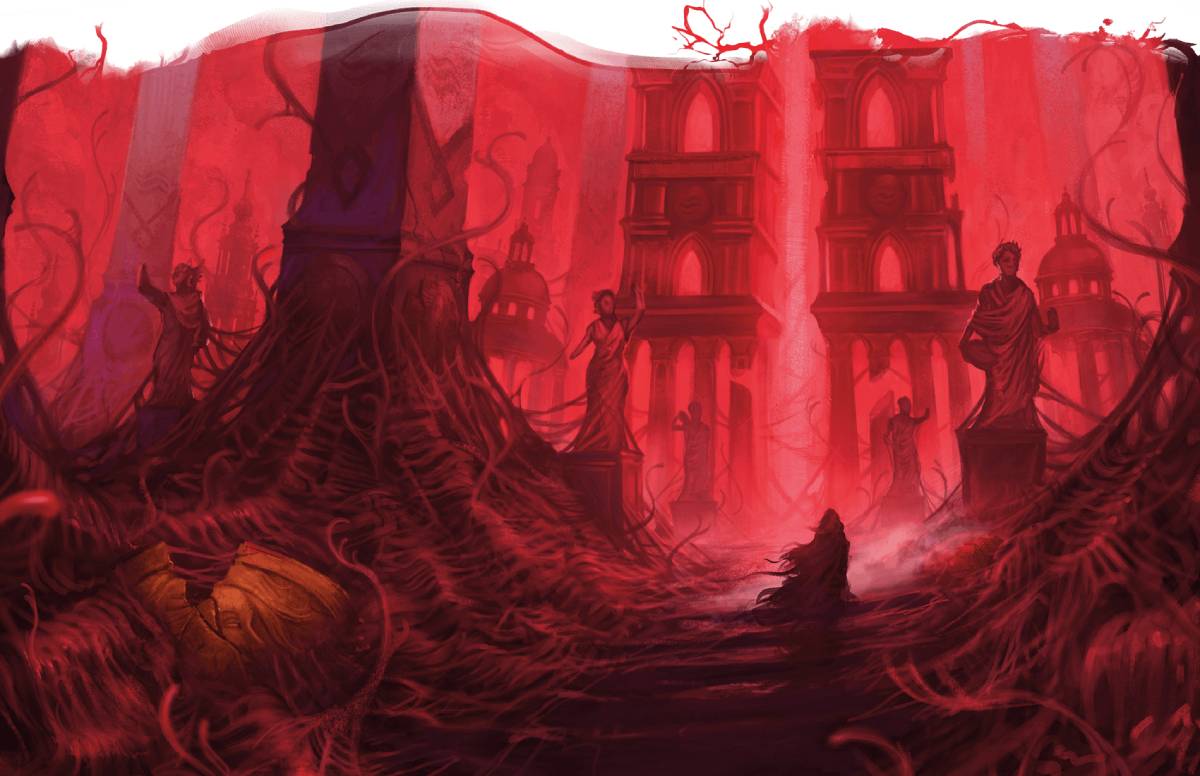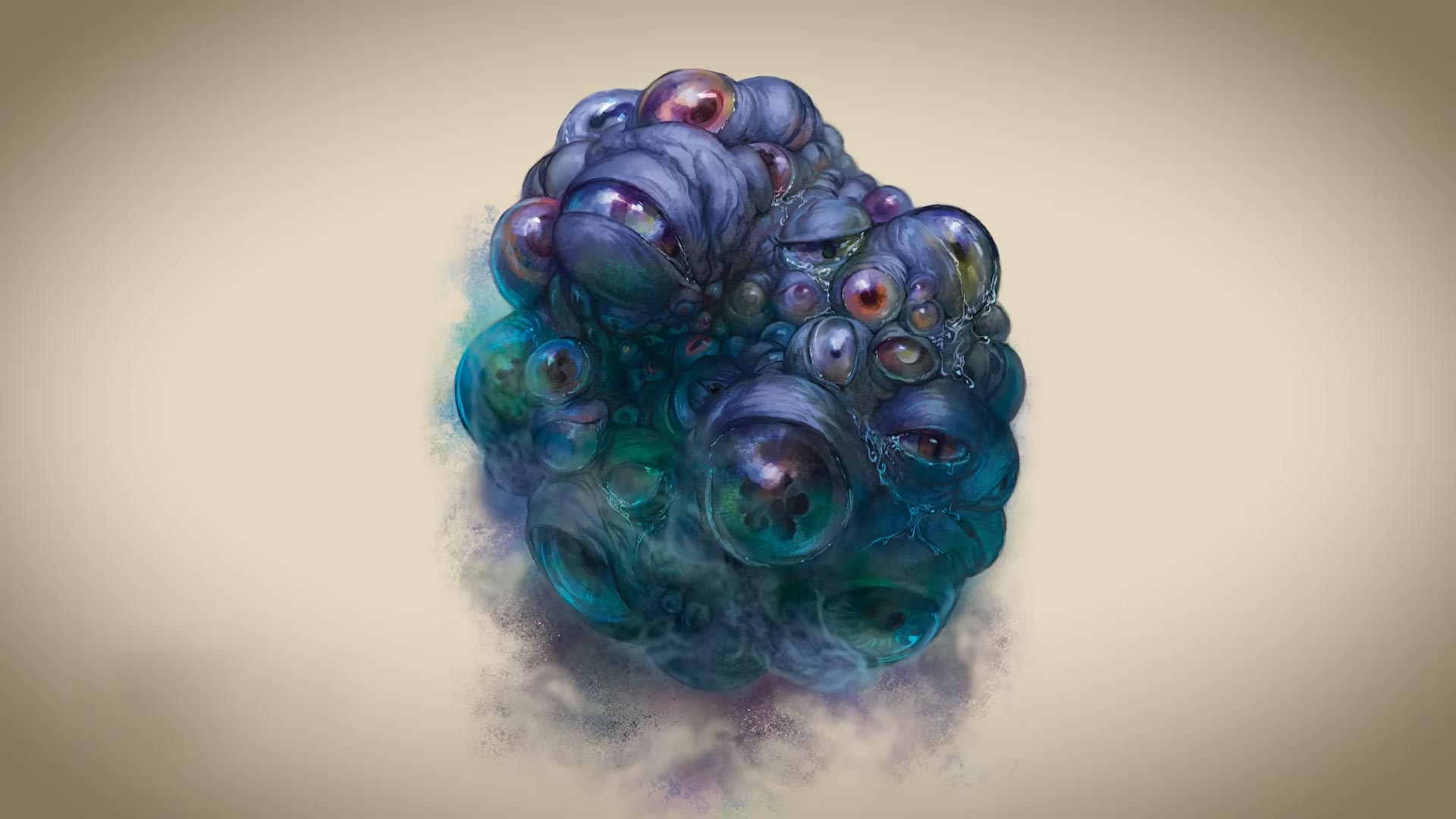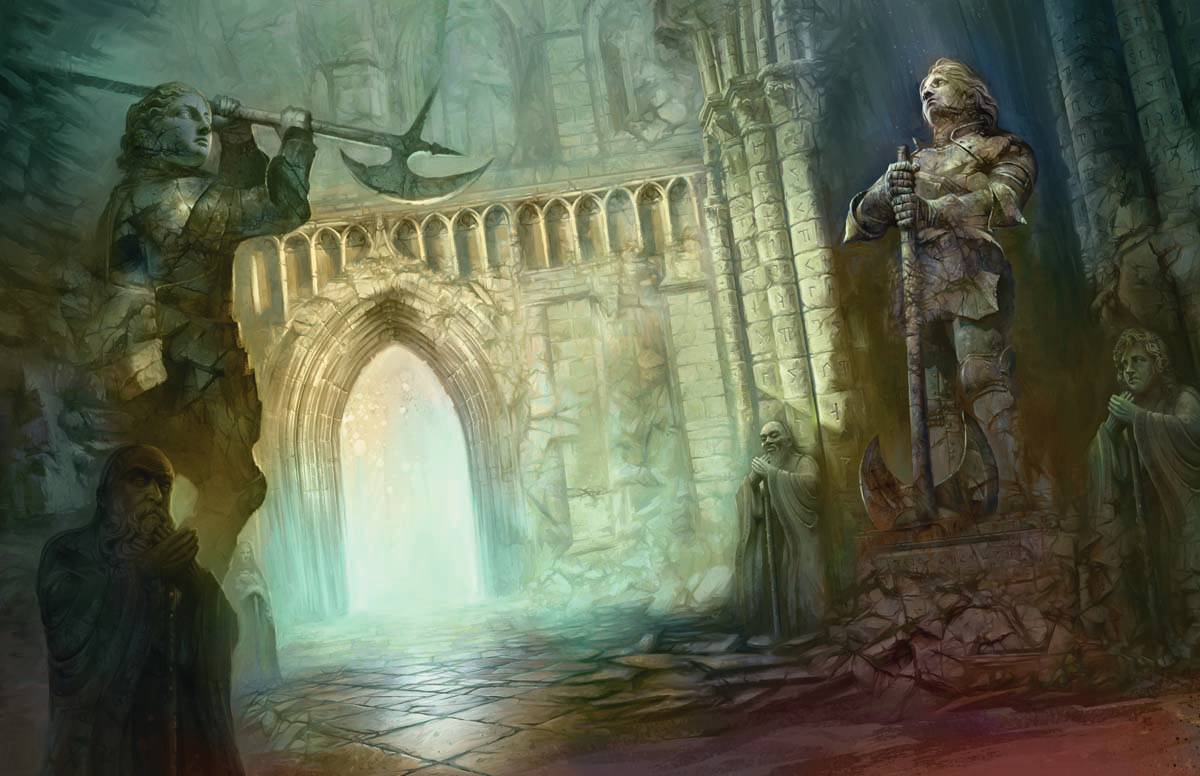Few things in life are more satisfying than seeing an egotistical, toxic narcissist melt into a pile of regret. And the oculorb from Phandelver and Below: The Shattered Obelisk perfectly illustrates this eye-catching truth.
These floating, partially deflated balloons, covered in sad eyes, provide a bit of Far Realm-flavored schadenfreude for D&D's classic, multi-eyed, egotists: the beholder.
Let’s take a closer look at these melancholy aberrations and see what lies behind all those sad, sad eyeballs.
Origins of the Oculorb

Due to the unknowable nature of the Far Realm, there is no clear-cut science behind how exactly an oculorb is created. Some may be birthed from the dreams of beholders, while others may be once mighty eye tyrants that have fallen and devolved into a slimy, floating bummer. But one thing is certain: Oculorbs appear to be the end result of a beholder having a crisis of confidence.
The legendary megalomania of beholders is well-documented across the multiverse. The dwarven sage Valkara Ironfell once said, “Every beholder thinks it is the epitome of beholderkin, and the only thing it fears is that it might be wrong.” They are avatars of avarice, refusing to share the slightest sliver of territory with anyone or anything, including other beholders.
So when confronted with the crushing realization that it may indeed not be “all that,” a beholder can create, or become, an oculorb.
How Are Oculorbs Created?
Normally, beholders reproduce by having intense dreams, manifesting copies of themselves, or other types of beholderkin, purely from their own headspace. Oculorbs are similarly dreamed into existence, but all other types of beholderkin regard these sad eye balloons with dread. Most beholders at best look down upon other beholderkin, but oculorbs inspire a unique type of pointed disdain and disgust amongst their progenitors.
So why do they exist? And why do they get a special flavor of hate from other beholders? One reasonable possibility (and take this with a grain of salt because we’re trying to apply reason to Far Realm nonsense) is that experiencing even one iota of self-doubt creates a deep ripple effect in the beholder’s egocentric psyche and the Far Realm itself. Rather than process this self-doubt, like a normal, well-adjusted psyche would, the beholder instinctively externalizes those icky notions of humility, compartmentalizing it until it unintentionally manifests it as a wet, pathetic oculorb.
There are also rumors that some oculorbs were once powerful beholders whose mighty egos were broken by some external force. These oculorbs once believed themselves to be the center of the universe, but now they wander the ruins of their former lives, eager to release their internalized rage and despair on others.
Destroy Your Party With Weaponized Angst

The oculorb may be a sad shadow of a beholder’s true power, but it does possess some strange abilities that your typical beholder lacks.
Oculorb Abilities
Oculorbs have a flight speed of 60 feet, as opposed to a classic beholder’s puttering 20-foot flight speed. It also possesses truesight up to a distance of 60 feet, which, oddly enough, beholders don’t have (they have eyes everywhere, but that apparently doesn't stop them from being fooled by illusion magic). Oculorbs also have resistance to all magic, they cannot be surprised, and they have advantage on initiative rolls. They do not, however, possess the same potpourri of potent eye rays that classic beholders have, but instead, they have learned how to weaponize their angst.
Oculorb Attacks
Its Dreadful Contact is a melee attack that deals 3d6 + 4 psychic damage, but it deals 6d6 + 4 psychic damage if the targeted creature is frightened. Their eye rays don’t have a variety of magical effects like their progenitors, but they can fire off four of them per round, and they all deal 3d6 + 4 psychic damage.
The oculorb’s “big gun,” so to speak, is an ability called Antipathic Flood, which must be recharged after it’s used. This wave of negative emotion unleashed upon its foes can take one of two forms. The first is called Weeping Eyes, which requires a DC 16 Constitution saving throw. On a failed save, an affected creature’s movement speed drops to 0, and they break concentration on any spell as despair overtakes their mind.
The other iteration of this Antipathic Flood is called Withering Glare, a 60-foot cone of scarlet energy that forces creatures to make a DC 16 Wisdom saving throw. On a failed save, a creature takes 6d10 necrotic damage and is frightened for 1 minute.
Lastly, when an oculorb is damaged by a creature that it can see (which, I mean, it has 60 feet of truesight, soo…), it can use its reaction to perform an Obsessive Rebuke, instantly dealing 3d6 damage to its attacker if they fail a Wisdom saving throw. This feels like the D&D equivalent of, “Oh, and one more thing…”
How to Use Oculorbs In Your Game

The fact that they appear to be the black sheep of beholderkin strangely makes the motivations of an oculors slightly relatable, which is novel because, ya know, it’s an aberration from the Far Realm. They are their progenitors' rage, despair, and perfectionism congealed into flesh. A true beholder is the naked emperor who believes he is fully clothed. The oculorb is the naked emperor who has seen himself in the mirror, and no matter how much it rages, it can’t go back to believing it’s fully clothed again.
Crush Your Party's Mojo
Their big, flashy attack, Antipathic Flood, is rooted in emotional stakes. If your players fail their Constitution saving throw to its Weeping Eyes ability, you could ask them to describe the saddest, lowest, most pathetic moment in their characters' lives, causing them to stop and weep uncontrollably. Similarly, when suffering under the frightened condition instigated by its Withering Gaze, you could ask your players to describe their characters’ greatest source of shame.
An Oculorb's Motivation (Or Lack Thereof)
An oculorb has nothing to lose. They have no status, riches, or valued knowledge to protect. If a beholder feels threatened, it will do what it can to escape or even the odds. The pitiful oculorb, however, seems like the type of aberration that will do whatever it takes to cause the most amount of pain before it is wiped from existence. Or maybe an oculorb you meet in a shattered Far Realm temple believes there is some strange ritual that can restore it to its proper status…
All Eyes On Me
These squishy, melancholic, wishing-well gazers are a fun twist on beholders that can open up juicy character and narrative-building moments for your game. If you’re interested in playing with a slightly less powerful member of the beholder family who’s been through a lot, this is your monster.
And if you’re looking for even more strange, mutated, twists on classic aberrations, go check out all the horrors within Phandelver and Below: The Shattered Obelisk!
Kyle Shire (@kyleshire) is a contributing writer to D&D Beyond and a producer for Critical Role. In the past, he worked as a producer, writer, and host for Machinima Studios and Warner Brothers Interactive Entertainment. He's appeared on HyperRPG as the Mayor of Kollok and the Saving Throw Show. He currently lives in Los Angeles.








-
View User Profile
-
Send Message
Posted Sep 14, 2023This is sad, disgusting, and so useful.
-
View User Profile
-
Send Message
Posted Sep 15, 2023Wait shoudent beholders have truesight afterall they have 11 eyes also 5e needs more abberations and this sounds good
-
View User Profile
-
Send Message
Posted Sep 15, 2023I am sure this was a prince song, right?
-
View User Profile
-
Send Message
Posted Sep 20, 2023Now, its my faworite aberration in D&D!
-
View User Profile
-
Send Message
Posted Sep 21, 2023I though so as well, however they actually don't have it, instead having 120 ft of darkvision and 22 passive perception. This weapon of mass destruction may be the shed-off of a beholder, but it should honestly be proud. it's actually way stronger than the original. Oh, and let's not forget, this thing CANNOT be surprised, has ADVANTAGE on iniative, and has as much movement as it does truesight. That's absurdly broken. And also, judging by the text, it says they don't hate each other. So.... Several at once?
-
View User Profile
-
Send Message
Posted Sep 26, 2023Nonono, you've got it all wrong. An Oculorb is created by last-hitting a beholder with a bards vicious mockery! Nothing could humiliate an enemy more than that.
-
View User Profile
-
Send Message
Posted Oct 20, 2023nnnnnoooooooookjp
-
View User Profile
-
Send Message
Posted Nov 10, 2023So, the abilities of this thing are, interesting, but it has the potential to go to some very dark places... Extreme Trigger Warning for the rollover: put your mental health before my ramblings. I have experience with anxiety, depression and the conditions and behaviours I mention below and I can find it hard to talk/read about sometimes, do not risk it if you believe you may be vulnerable too.*
So, weaponised anxiety? I can appreciate why the designers kept this fairly bland really, but the idea of being able to target pc's with depressive illnesses and to force them into self harm and other scenarios is extremely potent. Obviously, I stated a TW for a reason here, but I know that this wouldn't be inappropriate for some groups. I'm thinking that maybe the damage from some of these abilities could be described or explained as a target literally inflicting the damage on themselves, especially with that Dreadful Contact ability, the extra 3d6 damage to a frightened creature being from pulling their own weaponry on themselves is a torturous and powerful concept. Or an alternative ability of the Antipathic Flood being to inflict an eating or self-harm disorder to a despairing creature... a longer term condition that the party would then have to wrestle with; especially if it's not one that a paladin or cleric can just wash away like with a physical ailment... some things take more than a touch to get over, but I can see the roleplay (and potentially real-life) benefits of characters and players talking about such traumas, and I can foresee the Calm Emotions spell suddenly becomes an incredibly powerful tool too.
I don't think I have a party that I could go down these routes with at the moment, but the potential ramifications of a successful encounter with one of these creatures is... interesting and horrifying in equal measure. I'm thinking, the Calm Emotions spell could be extremely potent in both dealing with an Oculorb, and for helping people that have survived an encounter with one. I wonder how something like a Wand of Smiles might effect one too.
*I'm okay at the moment, and hope you are too, but it's okay to not be okay, and there are people you can turn to for help, even if you're not sure how to or even if you can talk about a problem.
UK Resources:
https://www.mentalhealth.org.uk/explore-mental-health/get-help
https://www.mind.org.uk/
https://mentalhealth-uk.org/help-and-information/downloadable-resources/
USA Resources:
https://www.nimh.nih.gov/health/find-help
https://www.cdc.gov/mentalhealth/tools-resources/index.htm
https://www.mentalhealthfirstaid.org/mental-health-resources/
💜